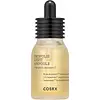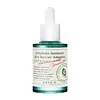What's inside
What's inside
 Key Ingredients
Key Ingredients

 Benefits
Benefits

 Ingredients Side-by-side
Ingredients Side-by-side

Water
Skin ConditioningAloe Barbadensis Leaf Water
MaskingButylene Glycol
HumectantSodium Hyaluronate
HumectantCentella Asiatica Extract
CleansingGlycerin
HumectantBetaine
HumectantPropanediol
SolventGlycyrrhiza Uralensis Root Extract
Skin ConditioningHieracium Umbellatum Extract
Skin ConditioningCynara Scolymus Leaf Extract
Skin ConditioningSorbitol
HumectantAloe Barbadensis Leaf Extract
EmollientDioscorea Japonica Root Extract
Skin ConditioningLaminaria Japonica Extract
Skin Protecting1,2-Hexanediol
Skin ConditioningXanthan Gum
EmulsifyingCarbomer
Emulsion StabilisingLinum Usitatissimum Seed Extract
PerfumingHibiscus Esculentus Fruit Extract
Skin ConditioningAloe Barbadensis Leaf Juice
Skin ConditioningArctium Lappa Root Extract
Skin ConditioningHibiscus Mutabilis Flower Extract
Skin ConditioningCorchorus Olitorius Leaf Extract
Skin ConditioningRheum Palmatum Root Extract
AstringentAlthaea Rosea Flower Extract
Skin ConditioningDimethyl Sulfone
SolventChlorphenesin
AntimicrobialEthylhexylglycerin
Skin ConditioningPolyglutamic Acid
Skin ConditioningBeta-Glucan
Skin ConditioningArginine
MaskingAllantoin
Skin ConditioningAdenosine
Skin ConditioningWater, Aloe Barbadensis Leaf Water, Butylene Glycol, Sodium Hyaluronate, Centella Asiatica Extract, Glycerin, Betaine, Propanediol, Glycyrrhiza Uralensis Root Extract, Hieracium Umbellatum Extract, Cynara Scolymus Leaf Extract, Sorbitol, Aloe Barbadensis Leaf Extract, Dioscorea Japonica Root Extract, Laminaria Japonica Extract, 1,2-Hexanediol, Xanthan Gum, Carbomer, Linum Usitatissimum Seed Extract, Hibiscus Esculentus Fruit Extract, Aloe Barbadensis Leaf Juice, Arctium Lappa Root Extract, Hibiscus Mutabilis Flower Extract, Corchorus Olitorius Leaf Extract, Rheum Palmatum Root Extract, Althaea Rosea Flower Extract, Dimethyl Sulfone, Chlorphenesin, Ethylhexylglycerin, Polyglutamic Acid, Beta-Glucan, Arginine, Allantoin, Adenosine
 Reviews
Reviews

Ingredients Explained
These ingredients are found in both products.
Ingredients higher up in an ingredient list are typically present in a larger amount.
1,2-Hexanediol is a synthetic liquid and another multi-functional powerhouse.
It is a:
- Humectant, drawing moisture into the skin
- Emollient, helping to soften skin
- Solvent, dispersing and stabilizing formulas
- Preservative booster, enhancing the antimicrobial activity of other preservatives
Arginine is an amino acid that is important for human development. Your body uses is it to produce hair keratin and skin collagen.
As a cosmetic ingredient, Arginine has antioxidant properties and can also help repair damaged skin. This ingredient is derived either synthetically or from animals.
Arginine isn't fungal acne safe when used in the presence of other lipids (fats, fatty acids, oils, esters, etc). Oils and fats occur naturally within the skin, so take caution when using Arginine if you're prone to fungal acne.
Learn more about ArginineBetaine is a common humectant (a substance that promotes retention of moisture). It's known to be gentle on the skin and can help balance hydration.
This ingredient is best for improving hydration and soothing irritated skin. Studies also show it helps even out skin tone.
Fun fact: Betaine is naturally created in the skin and body. The kind found within cosmetic products can be either plant-derived or synthetic.
Another name for betaine is trimethylglycine.
Learn more about BetaineButylene Glycol (or BG) is used within cosmetic products for a few different reasons:
Overall, Butylene Glycol is a safe and well-rounded ingredient that works well with other ingredients.
Though this ingredient works well with most skin types, some people with sensitive skin may experience a reaction such as allergic rashes, closed comedones, or itchiness.
Learn more about Butylene GlycolCarbomer is a polymer of acrylic acid. Its main role is to create a gel consistency.
A high amount of carbomer can cause pilling or balling up of products. Don't worry, most products contain 1% or less of carbomer.
Glycerin is already naturally found in your skin. It helps moisturize and protect your skin.
A study from 2016 found glycerin to be more effective as a humectant than AHAs and hyaluronic acid.
As a humectant, it helps the skin stay hydrated by pulling moisture to your skin. The low molecular weight of glycerin allows it to pull moisture into the deeper layers of your skin.
Hydrated skin improves your skin barrier; Your skin barrier helps protect against irritants and bacteria.
Glycerin has also been found to have antimicrobial and antiviral properties. Due to these properties, glycerin is often used in wound and burn treatments.
In cosmetics, glycerin is usually derived from plants such as soybean or palm. However, it can also be sourced from animals, such as tallow or animal fat.
This ingredient is organic, colorless, odorless, and non-toxic.
Glycerin is the name for this ingredient in American English. British English uses Glycerol/Glycerine.
Learn more about GlycerinSodium Hyaluronate is hyaluronic acid's salt form. It is commonly derived from the sodium salt of hyaluronic acid.
Like hyaluronic acid, it is great at holding water and acts as a humectant. This makes it a great skin hydrating ingredient.
Sodium Hyaluronate is naturally occurring in our bodies and is mostly found in eye fluid and joints.
These are some other common types of Hyaluronic Acid:
Learn more about Sodium Hyaluronate